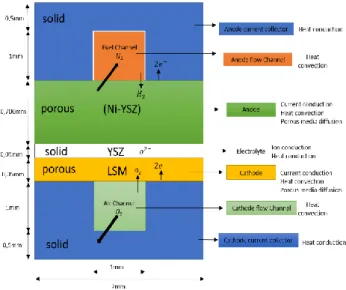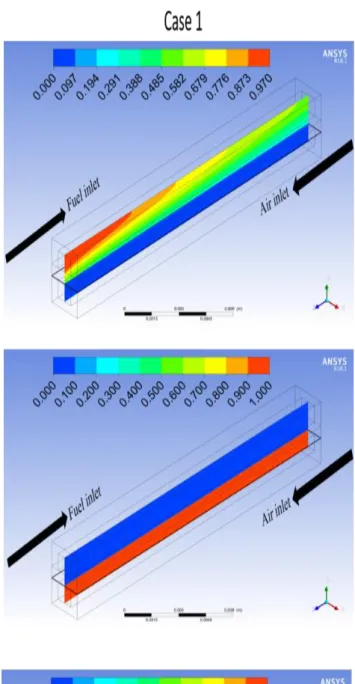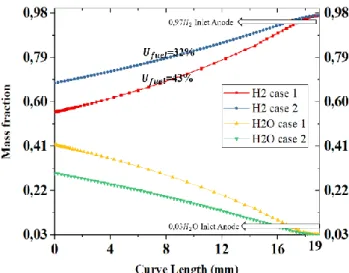Study the effect of gas channel surface on anode
supported planar of Solid oxide fuel cell
performance
Horr Sabrina1 and Hocine Mohcene11Laboratory for the development of new and renewable energies in arid zones (LENREZA), University Kasdi Merbah Ouargla, Ouargla 30000, Alegria
E-mail : sabrina.sabi2005@gmail.com
Abstract—This study focuses on the effect of gas channel
surface on the performance of solid oxide fuel cell using ANSYS FLUENT. Firstly the model is validated using one of the available numerical results from previous researches the comparison between the numerical model and the reported results shows very good agreement. Secondly Study the Mesh independency to ensure that the model results are independent of the grid size. Two different configurations of the Solid Oxide Fuel Cells are examined :i) the Anode Supported Planar Solid Oxide Fuel Cell (ASP_SOFC) with channel gas surface 1mm² and ii) ASP_SOFC with channel gas surface 0.25mm². This study modeled and compared the performance of a single SOFC at T=1123K under the specified inlet operating conditions.
Keywords—Solid oxide fuel cell, Performance SOFC, channel gas, ANSYS FLUENT, modeling, simulation.
I. INTRODUCTION
The Solid Oxide Fuel Cell (SOFC) is an all solid type of high-temperature (600-1000°C) fuel cell that can directly convert any mixture of hydrogen, carbon monoxide and methane into electricity. Solid-oxide fuel cells (SOFCs) have the highest performance and durability. [1]
II. SOFCOPERATINGPRINCIPAL
SOFC fuel cell composed of a fuel-flow channel, anode gas diffusion layer, anode catalyst layer, electrolyte, cathode catalyst layer, cathode gas diffusion layer, air-flow channel, and anode and cathode collectors [6].The schematic view of SOFC is depicted in Fig. 1. For an SOFC cell, water is formed at the anode. Electrochemical reactions at the anode and cathode respectively [2]:
At Anode : H2 + O2- → H2O + 2 e- (1) At Cathode : O2 + 2 e- → O2- (2)
The overall cell reaction is H2 + O2 → H2O
Fig. 1: 3D view for a planar SOFC counter-flow [3].
III. NUMERICALSTUDY
A. Model Description
A geometric modeling and meshing software GAMBIT (version 2.4.6) was used for developing the mode the design is a counter-flow with anode supported Details of the dimension are show in TABLE 1 and are shown in Fig. 2. Different cell models are considered, depending on the surface channel dimension.Fig.3 demonstrates the schematic of SOFC which we take it in our study consisting of the gas channels, gas diffusion layers (GDL), electrolyte, catalyst layers (CL) and current collectors.
Fig. 2: Dimensions of single channel SOFC.
Fig. 3: Dimension gas channel cases studies.
TABLE 1: GEOMETRICAL PARAMETERS
GEOMETRICAL PARAMETERS zone Dimension(mm) Cell width 2 Cell length 19 Anode thickness 0.700 Cathode thickness 0.05 Electrolyte thickness 0.01
Channel height Validation and Case 1: 1
Case 2: 0.5
Channel width Validation and Case 1: 1
Case 2: 0.5
Current collector height 1.5
B. Computational Domain
The geometric model is created and mesh in Gambit 2.4.6.Then the geometry was solved in the commercial CFD software ANSYS FLUENT 18.1 that is based on the finite volume method (FVM). The domain was divided into hexahedral volume elements in Gambit. The detailed schematic of computational domain is illustrated in Fig. 4. The whole computational domain contains 270.000 cells mesh is found to provide a sufficient resolution in the first based reference model.
Fig. 4: Model meshing.
C. Boundary condition
In this study, the “mass flow inlet” and “pressure outlet” boundary conditions were assigned at the inlet and outlet ports of the anode and cathode gas channels, respectively. The “wall” boundary condition are considered as adiabatic was assigned at the terminal surfaces of current collector (anode and cathode) and Cell surroundings. Details of the boundary condition in TABLE 2.
The fuel is fed into the fuel cell as a mixture of gases. The gas mixture that is fed through the anode inlet consists of hydrogen and water vapor. The gas that is fed through the cathode inlet consists of oxygen. The mass fraction for hydrogen is set as 0.97 and the mass fraction for water vapor in the anode fuel mixture is set as 0.03. The mass fraction for oxygen is set as 1 at the cathode side
TABLE 2: BOUNDARY CONDITION
parameter BC Temperature
Hydrogen inlet Mass flow inlet
(kg/s) 1.141 × 10-8
1123 K
Oxygen inlet Mass flow inlet
(kg/s) 2.287× 10-7
1123 K
Hydrogen outlet Pressure outlet Convection
Oxygen outlet Pressure outlet Convection
Terminal anode collector Wall Adiabatic Terminal cathode collector Wall Adiabatic Cell surroundings Wall Adiabatic
D. Assumptions
SOFC fuel cell operates under steady-state conditions. Operation temperature is assumed to be 1123 K. The reactants are pure hydrogen and air. They follow the ideal gas law. The gas flow is laminar and incompressible. The gas diffusion layers, catalyst layers, and electrolyte layer are isotropic materials. Single channel and counter-flow is assumed.
E. Solution Procedure
Steady-state simulations and second order discretization for all equations were used in this study Multigrid cycle was changed for F-Cycle for all equations. Stabilization method was chosen (Bi-conjugate gradient stabilization) BCGSTAB for species concentrations, water saturation, electric and protonic potential. Terminal restrictions were changed 0.001 for species concentrations, water saturation and for 0.0001 for electric and protonic potential. Maximum number of cycles was increased for 50. [7]
IV. MODELVALIDATION
The cell voltage versus as the current density curve for the presented model was compared with data [3]; this comparison is shown in Fig. 5, showed a good agreement.
Fig. 5: Comparison between our results and
numerically data obtained by [3].
V. RESULTSANDDISCUSSIONS
A. Performance
The fuel cell performance is obtained by polarization curves which relate the cell voltage and power density to both [4,5]; Fig. 6 shows the predicted cell voltage and power density as a function of current density, in case 1 and case 2, for the previous conditions operating. The performance of a cell is significantly highest in case 1 than case 2. The maximum power density is 2.03 W/cm² at 5.08 A/cm² while the case 2 the maximum power density is 1.06 W/cm² at 2.65 A/cm².
Fig. 6: cell voltage and power density curves.
B. Ohmic losses
There seems to be little difference between case 1 and 2, for Ohmic losses. This can explain by the small dimensions of the cell the distance of the small cell, Fig. 7.
Fig. 7: Ohmic overpotential curve.
C. Mass fraction species
The counter flow channel ASP SOFC case 1 shows a better mass fraction of the reactants species than case 2 and better current distributions as well. Fig. 8 shows mass fraction of H2, O2 and H2O in a plan (YZ) centered (X=1) at the flow channel in both cases at 0.6V.Fig. 9 explain more mass fraction distribution along the anode channel of the reactants species for both cases, better distribution resulting a better value for utilization Fuel Ufuel.
Fig. 9: Variation of H2 and H2O mass fraction distribution along
the anode channel in cases 1 and 2, at 0.6 v.
D. Current density flux magnitude
Current density flux maximum is 1.267 e+05A/cm² and 6.77e+04A/cm². In case 1 and case 2 respectively, is shown by Fig. 10.
REFERENCES
[1] Ryan O’Hayre, Suk-Won Cha, Whitney Colella, and Fritz B. Prinz, Fuel Cell Fundamentals, Wiley; 2nd edition, 2009.
[2] Subhash C Singhal and Kevin Kendall, High-temperature Solid Oxide FuelCells:Fundamentals, Design and Applications, Elsevier Science; 1st edition, 2003.
[3] M. Saied. Investigations of solid oxide fuel cells with functionally graded electrodes for high performance and safe thermal stress.international journal o f hydrogen energy42 (2017)15887-15902.
[4] Barzi YM, Raoufi A, Rasi NM, Davari S. Three dimensional simulation of a counter-flow planar solid oxide fuel cell.ECS Transactions 2011.
[5] Chaisantikulwat a, Diaz-Goano C, Meadows ES. Dynamic modelling and control of planar anode-supported solid oxide fuel cell. Comput Chem Eng 2008.
[6] EG&G Technical Services, Inc. «Fuel Cell Handbook (Seventh Edition) », 11/2004.
[7] ANSYS Inc, ANSYS FLUENT 18.1 fuel cells module manual
Fig. 10: Compare distribution of current density magnitude in
cases 1 and 2, at 0.6 v.
VI. CONCLUSION
In the present work, the effect of surface gas channel at an ASP-SOFC is studied. The location of the highest performance was found at case 1 witch have higher surface. Cell performance significantly increased due to the rapid electrochemical reactions and the higher ionic conductivity. So when the surface channel increase the performance increased.
![Fig. 1 : 3D view for a planar SOFC counter-flow [3].](https://thumb-eu.123doks.com/thumbv2/123doknet/12280156.322388/1.892.487.825.330.805/fig-d-view-planar-sofc-counter-flow.webp)

![Fig. 5: Comparison between our results and numerically data obtained by [3].](https://thumb-eu.123doks.com/thumbv2/123doknet/12280156.322388/3.892.463.829.89.401/fig-comparison-results-numerically-data-obtained.webp)

